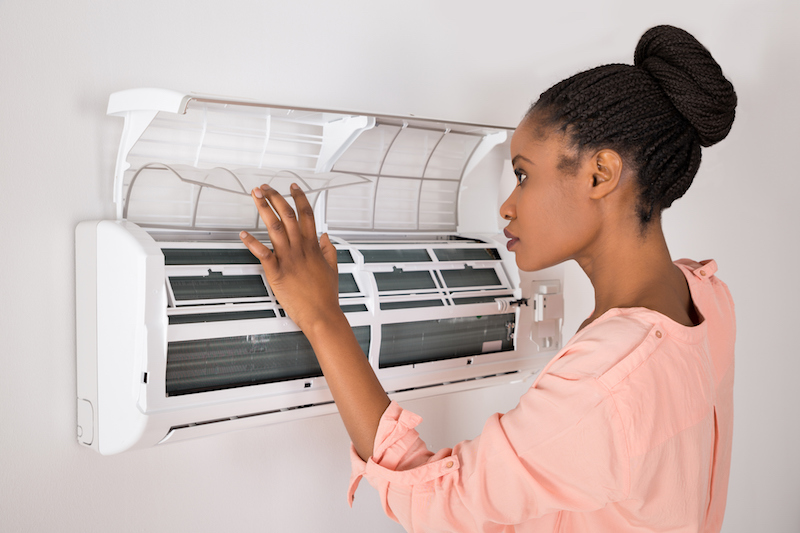
You shouldn’t be forced to give up comfort or drain your wallet to keep your residence at a refreshing setting during muggy weather.
But what is the ideal setting, exactly? We discuss suggestions from energy specialists so you can determine the best temp for your loved ones.
Here’s what we advise for the most energy-efficient setting for air conditioning in Columbus.
Recommended Thermostat Settings for Summer
Most households find using the thermostat at 72-73 degrees is ideal. However, if there’s a sizeable difference between your indoor and outdoor temperatures, your AC costs will be bigger.
These are our suggestions based on the U.S. Department of Energy (DOE) and ENERGY STAR®.
While at home: 78 degrees. While that seems warm, there are ways you can keep your home refreshing without having the air conditioner on frequently.
Keeping windows and window treatments closed during the day keeps cold air where it should be—indoors. Some window treatments, including honeycomb shades or plantation shutters, are made to give more insulation and better energy savings.
If you have ceiling fans in your residence, the DOE says you can raise thermostat temps about 4 degrees higher without sacrificing comfort. That’s since they freshen with a windchill effect. As they cool people, not rooms, shut them off when you exit a room.
If 78 degrees still appears too warm on the surface, try doing a test for a week or so. Get started by increasing your temperature to 78 degrees while you’re home. Then, progressively decrease it while using the advice above. You might be surprised at how comfortable you feel at a warmer temperature setting.
While away: 88 degrees. There’s no reason to keep the air conditioner running all day while your home is unoccupied. Switching the temp 7–10 degrees higher can save you as much as 5–15% on your electrical bills, according to the DOE.
When you arrive home, don’t be tempted to switch your thermostat under 78 to cool your house more rapidly. This isn’t productive and typically produces a more expensive AC expense.
A programmable thermostat is a useful method to keep your settings controlled, but you have to set programs. If you don’t utilize programs, you might forget to increase the set temperature when you take off.
If you want a hassle-free fix, think about getting a smart thermostat. This thermostat links with your phone, so it knows when you’re at home and when you’re gone. Then it intuitively changes temperature settings for the biggest savings. How much exactly? An estimated $180 annually on heating and cooling, according to ENERGY STAR.
Another benefit of getting a smart thermostat? You can use your phone to keep an eye on and adjust temperature settings from almost anywhere.
While sleeping: Around 70 degrees. While ENERGY STAR recommends 82 degrees, that might be unpleasant for many families. Many people sleep better when their sleeping space is chilled, so that’s why the National Sleep Foundation advises 60–67 degrees. But that might be too cool, due to your PJ and blanket preference.
We suggest using a similar test over a week, putting your thermostat higher and slowly decreasing it to choose the best temperature for your house. On pleasant nights, you might find keeping windows open at night and using a ceiling fan is a preferable idea than using the AC.
More Ways to Use Less Energy This Summer
There are additional methods you can spend less money on cooling bills throughout the summer.
- Upgrade to an energy-efficient air conditioning system. Central air conditioners only work for about 12–15 years and become less efficient as they age. An updated air conditioner can keep your home more comfortable while keeping utility bills low.
- Schedule regular air conditioner tune-ups. Routine air conditioner maintenance keeps your equipment operating like it should and could help it run at better efficiency. It could also help lengthen its life cycle, since it allows techs to find little problems before they cause a major meltdown.
- Put in new air filters frequently. Read manufacturer instructions for switching your air filter. A dirty filter can cause your system to short cycle, or turn on and off too often, and raise your energy.
- Check attic insulation levels. Almost 90% of residences in the United States don’t have enough insulation, according to the Insulation Institute. The majority of southern climates need 13–14” of attic insulation, while northern climates should have 16–18”.
- Have your ductwork inspected. Ductwork that has come apart over time can leak cool air into your attic, walls or crawl space. This can result in huge comfort troubles in your home, such as hot and cold spots.
- Seal cracks, doors and windows. Keep warm air in its place by sealing openings. You can also caulk or weather strip doors to keep more conditioned air inside.
Conserve More Energy During Warm Weather with Classic Air
If you want to use less energy this summer, our Classic Air specialists can assist you. Get in touch with us at 614-210-3041 or contact us online for additional details about our energy-saving cooling options.
